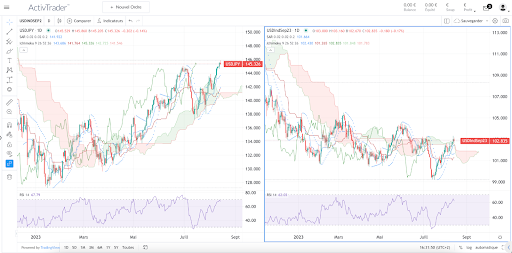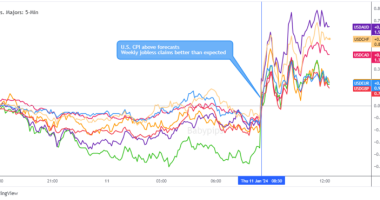Since the Bank of Japan changed its position on its yield curve management policy at its last meeting at the end of July, the yen has been gradually losing value.
This latest adjustment has caused the value of 10-year Japanese government bonds to rise to its highest level in the last nine years.
As yield differentials have expanded, the Japanese yen has fallen close to the point that prompted the first yen-buying intervention from the BoJ since the late 1990s.
Last year, the Japanese government eventually stepped in and acquired ¥$2.84 trillion on September 22nd, when the exchange rate was ¥145.90.
Not far from where it sits right now at ¥145.46 at the time of writing according to ActivTrades’ Forex data.
Meanwhile, the value of the USD has been on an upward trend since the end of last month. This is shown by the fact that the dollar index has increased from a low point of 99.77 on July 13th to its current level of 103.069 at the time of writing.
Another significant aspect to consider is that investors are acquiring the dollar as a safe haven due to apprehensions over the state of the global economy, with a particular focus on China.
The depreciation of the yen has contributed to an increase in consumer price inflation in Japan since it has led to higher import prices for a country that is limited in its resources. This has obviously been a significant challenge for consumers and is something the BoJ works to avoid.
Japan also faces the possibility of more currency depreciation as global central banks’ aggressive tightening strategies make the BoJ stand apart by continuing its easing strategy. As a result, investors will often invest in countries where their assets will generate higher rates of return, like the United States.
Let’s take a brief look at the current situation in Japan.
July Monetary Policy Meeting recap
In its July 28th meeting, the Bank of Japan unanimously voted to keep its main short-term interest rate at -0.1% and that of 10-year bond yields at about 0%.
They did, however, decide to make their yield curve management policy more flexible in an effort to strengthen the long-term viability of stimulus policy. The board clarified that the 0.5% yield movement limit was more of a guideline than a hard and fast rule.
In its most recent quarterly outlook report, the bank predicted that the economy would revive gradually, helped along by a backlog of demand. Inflation is expected to slow as the impact of previous increases in import costs continues to fade.
After that, the numbers are expected to pick up speed once again due to an improvement in the production gap and rising inflation expectations, and wage increases.
The board has said that it intends to keep increasing the monetary base until inflation rates reach and remain persistently above the 2% objective it has set.
What’s new in the economic data
Preliminary statistics released on Monday reveal that the Japanese economy expanded by 1.5% quarter over quarter in the second quarter this year, above market expectations of a 0.8% increase and quickening the upwardly revised 0.9% gain in the first three months of the year.
This was the second consecutive quarter of growth and the quickest pace since the fourth quarter of 2020, aided by a favorable contribution from net trade as exports recovered.
Exports grew at their fastest rate in two years, while imports declined for the third straight quarter. Meanwhile, despite weak company investment and a decline in private consumption, government spending has been on the rise.
In June, Japan’s annual headline inflation rate inched up to 3.3% from 3.2% in May, falling short of market expectations. Also as predicted, the core consumer price index (which does not include fresh food but does include fuel expenses) increased by 3.3% in June compared to the same month a year earlier.
The next round of inflation data is due to come out on the 17th of August at 11:30 PM GMT, and while the headline rate may increase slightly, the core rate is forecast to fall by a small margin.
Finance Minister assures action will be taken in currency markets if necessary
According to Japanese Finance Minister Shunichi Suzuki last Tuesday, the Ministry is monitoring market fluctuations with a heightened feeling of urgency and will react in a suitable manner to excessive actions.
However, the intervention measures taken by authorities in the market do not aim to target absolute currency values as many point to the psychological level of ¥145.
When queried about whether the exchange rate of ¥145 is deemed a threshold for intervention, Suzuki responded by suggesting that there is no intention to establish a definitive value or to defend it in the event of a breach.
Instead, they intend to evaluate the nature of market movements, specifically examining whether they are driven by speculation, volatility, or grounded in fundamental factors, rather than only concentrating on absolute levels.
The information provided does not constitute investment research. The material has not been prepared in accordance with the legal requirements designed to promote the independence of investment research and as such is to be considered to be a marketing communication.<
All information has been prepared by ActivTrades (“AT”). The information does not contain a record of AT’s prices, or an offer of or solicitation for a transaction in any financial instrument. No representation or warranty is given as to the accuracy or completeness of this information.
Any material provided does not have regard to the specific investment objective and financial situation of any person who may receive it. Past performance is not a reliable indicator of future performance. AT provides an execution-only service. Consequently, any person acting on the information provided does so at their own risk.










